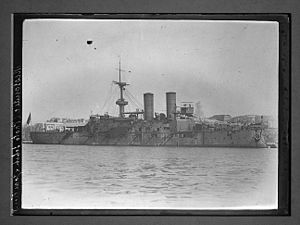- Ottoman ironclad Mesudiye
-

Ottoman ironclad MesudiyeCareer (Ottoman Empire) 
Name: Mesudiye Builder: Thames Iron Works Laid down: 1872 Launched: 1874 Commissioned: December 1875 Fate: Sunk, 13 December 1914, by British submarine B-11 General characteristics Class and type: Central-battery ironclad Tonnage: 9,250 Speed: 16 kn (30 km/h; 18 mph) Complement: 673 Armament: (1903 rebuld) 2×240mm (not fitted)
12 x 152mm
14 x 76mm 10×57mm 2×47mm gunsNotes: rebuilt in Italy, 1903 The Ottoman ironclad Mesudiye (Ottoman Turkish: Mesudiye Zırhlı Firkateyn-i Hümayunu / "The Royal Armoured Frigate Mesudiye") was originally a central-battery ironclad of the Ottoman Navy, first commissioned in 1875, rebuilt into a pre-dreadnaught type vessel in 1903, and serving until sunk by a British submarine in 1914.
Contents
History
As originally constructed, the Mesudiye was one of a number of armoured warships ordered by Sultan Abdülaziz from Britain, Austria-Hungary and France. She was ordered from the Thames Iron Works in 1871, laid down in 1872, and launched in 1874. Designed by Edward James Reed, she was the largest central battery warship ever constructed and had wrought iron belt and battery armour up to 12 in (300 mm) thick. She was commissioned in December 1875 following completion of her trials, and at the time was considered one of the most powerful warships in the world.[1] Her sister ship Hamidieh was bought by the Royal Navy before delivery as HMS Superb.
In 1903 Mesudiye was sent to the Ansaldo shipyards in Genoa, Italy, for a complete rebuild. Her three masts were replaced with a single mast, and two turrets were fitted. The 10 inch MLRs in her central battery were replaced with modern 6 inch (15 cm) guns, but as the heavy guns for the turrets were not ready at the time the refit ended, wooden guns were fitted in their place.[2] This was still the case in 1914.[2]
Balkan Wars
In the First Balkan War, Mesudiye participated in both naval battles with the Royal Hellenic Navy, at Elli on 16 December 1912 and at Lemnos on 18 January 1913. In both engagements, the Ottoman fleet was unable to break the Greek naval blockade of the Dardanelles. Mesudiye was not harmed in the first, but was damaged in the second.
World War I
At the beginning of World War I Mesudiye was ordered to anchor just south of the Dardanelles Narrows at Chanak, in Sarisiglar Bay as a floating battery to protect the minefields. Both the ship's captain, Besiktasli Arif Nebi, and several officers protested this order, but the opinions of the German naval advisors prevailed.
Sinking
On 13 December 1914 the British submarine B-11 entered the Dardanelles, and torpedoed the Mesudiye from a range of 800 m (2,600 ft) exactly at noon, as the ship's crew gathered belowdecks for lunch. Lookouts saw the torpedo and B-11's periscope, and sounded the alarm, and the Mesudiye’s guns began to fire towards the point where the submarine had been sighted. The impact of the first torpedo caused the Mesudiye to heel severely. She capsized in 10 minutes, trapping most of the crew; however, as she was lying in shoal water, most of the hull was above the surface, so most of her crew were rescued by cutting through the hull. Thirty-seven men were killed in all, 10 officers and 27 men.
The Mesudiye’s guns were salvaged and mounted in a shore battery bearing her name, and later caused substantial damage to the French battleship Bouvet on 18 March 1915.
Notes
- ^ Emir Yeneer. "Naval Revolution in the East". Scribd. http://www.scribd.com/doc/241915/Naval-Revolution-in-East. Retrieved 2008-06-05.
- ^ a b Kopp, George, Two Lone Ships, p80
References
- Naval History World War I Ottoman navy
- Mesudiye Photograph of the ship and other Gallipoli related naval images
Categories:- Battleships of the Ottoman Navy
- Battleships of the United Kingdom
- Leamouth-built ships
- 1874 ships
- Ironclad ships of the Ottoman Navy
- Naval ships of the Ottoman Empire in the Balkan Wars
- World War I naval ships of the Ottoman Empire
- Ships sunk by British submarines
- World War I shipwrecks in the Dardanelles
- Maritime incidents in 1914
Wikimedia Foundation. 2010.

